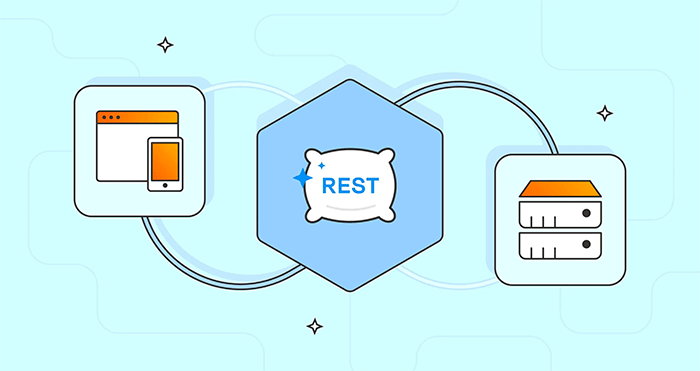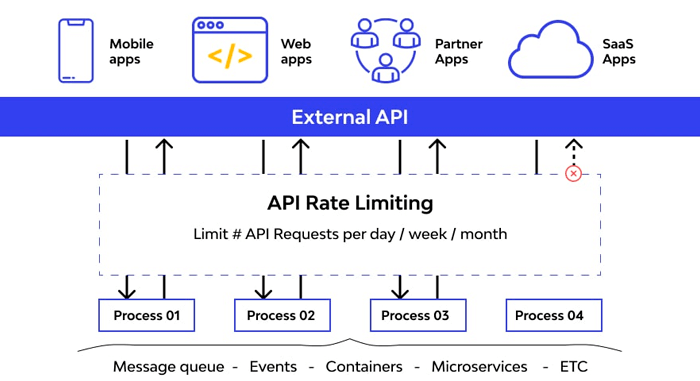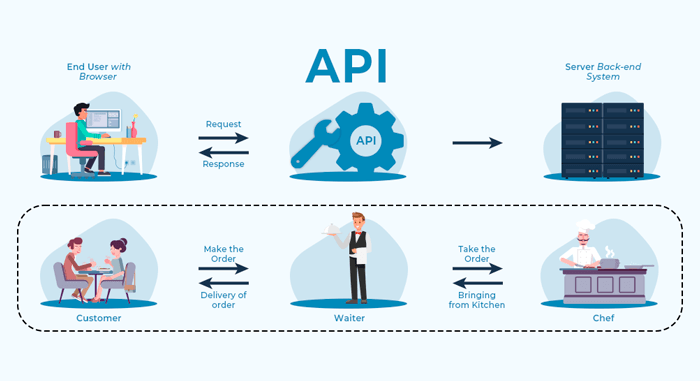Building RESTful APIs with Spring Boot: A Complete Guide

Building RESTful APIs with Spring Boot is the market standard for Java developers, as the framework simplifies configuration, accelerates development, and offers a robust ecosystem for creating scalable, high-performance web services.
In the current software development landscape, creating efficient and scalable web services is essential. The microservices architecture, driven by the need for agility and resilience, has made RESTful APIs with Spring Boot the default choice for millions of Java developers. But what makes this combination so powerful? The answer lies in the simplicity, convenience, and vast ecosystem that Spring Boot offers, allowing the developer to focus on business logic, not infrastructure complexity. This complete guide is your map to mastering the art of building robust and secure RESTful APIs using the most popular framework in the Java universe.
The Essentials of Spring Boot and REST Architecture
To build a successful API, it is crucial to understand the pillars that support it. Spring Boot is a framework that simplifies the use of the Spring ecosystem, eliminating the need for complex and repetitive configurations. It adopts the “Convention over Configuration” philosophy, allowing you to start a functional project with few lines of code. This characteristic has made it the darling of the Java community for rapid application development.
On the other hand, the REST (Representational State Transfer) architecture defines a set of principles for communication between systems. A RESTful API adheres to these principles, using HTTP methods (GET, POST, PUT, DELETE) to manipulate resources (data). The beauty of REST lies in its stateless nature, which facilitates scalability and interoperability. The combination of Spring Boot with REST principles results in an agile development process and the delivery of clean, well-structured APIs.
Why Does Spring Boot Dominate API Development?
Spring Boot’s success is no accident. It solves chronic problems in traditional Java development, such as dependency management and server configuration. With Spring Boot, creating an initial project and running an embedded server (like Tomcat or Jetty) are tasks that take only a few minutes. This agility is invaluable in a development environment that demands continuous delivery and rapid iterations.
- Auto-configuration: Automatically detects dependencies on the classpath and intelligently configures the application.
- Embedded Servers: Allows the application to be run as a standalone JAR file, simplifying deployment.
- Spring Initializr: A web tool that generates the basic project structure with the necessary dependencies in seconds.
- Monitoring and Metrics: Spring Boot Actuator provides ready-to-use endpoints for monitoring and managing the application in production.
The union of Spring Boot with REST is a perfect symbiosis. The framework offers powerful annotations, such as @RestController and @RequestMapping, which transform ordinary Java classes into API controllers ready to map HTTP requests and return responses in formats like JSON or XML. This abstraction allows the developer to focus on modeling resources and business logic, ensuring the API is intuitive and follows RESTful design best practices. In short, Spring Boot’s configuration convenience accelerates the creation of APIs that are inherently easy to scale and maintain.
RESTful Resource Design and Modeling
A well-designed RESTful API is intuitive and easy to be consumed by other developers. The API design must be centered on resources, which are the data entities the API manages. Instead of focusing on actions (verbs), the focus should be on the resource itself (nouns). This resource-oriented approach is the backbone of quality RESTful design and is essential for the longevity and maintainability of your API.
Modeling begins with identifying the main nouns of your business domain. If you are building an API for a blog, your resources might be “posts,” “comments,” and “authors.” Each resource must be accessible by a unique and meaningful URL (Uniform Resource Locator). The use of plural nouns to represent collections (e.g., `/api/posts`) and the combination of HTTP methods for CRUD (Create, Read, Update, Delete) operations are the golden rules of REST design.
Naming Conventions and HTTP Verbs
Consistency in naming is vital. Endpoints must be clear, concise, and use English (or your team’s standard language) to avoid ambiguity. The correct use of HTTP verbs is what differentiates a RESTful API from a simple HTTP service. Each verb has a semantic meaning that informs the client which operation will be performed on the resource.
- GET: Used to query a resource or a collection of resources. It must be idempotent and safe.
- POST: Used to create a new resource in a collection.
- PUT: Used to completely update an existing resource.
- DELETE: Used to remove a specific resource.
A common mistake is using GET to perform operations that modify the server state. A well-designed API ensures that data reading is always done with GET and that modifications are performed with POST, PUT, or DELETE, respecting HTTP semantics. Furthermore, the API must always return appropriate HTTP status codes (200 OK, 201 Created, 404 Not Found, 500 Internal Server Error) so that the client knows the exact result of its request. Spring Boot simplifies the mapping of these verbs and the return of status codes through annotations like @GetMapping and the ResponseEntity class.
Data Persistence with Spring Data JPA
Every API that deals with data needs a persistence layer. In the Spring Boot ecosystem, the most popular and efficient solution is Spring Data JPA. JPA (Java Persistence API) is the Java specification for data persistence, and Spring Data greatly simplifies the implementation of this specification, eliminating most of the boilerplate code required for basic database operations.
With Spring Data JPA, you don’t need to write repository implementations for CRUD operations. Just define an interface that extends JpaRepository, and Spring Data automatically generates the necessary code at runtime. This allows the developer to focus on complex queries and business logic, rather than worrying about opening and closing connections, transactions, and result mapping.
Entity and Repository Mapping
The foundation of Spring Data JPA is Entities and Repositories. Entities are Java classes that represent tables in the database, mapped with annotations like @Entity and @Id. Repositories are interfaces that define data access methods. The power of Spring Data lies in its ability to automatically create queries from the method name.
- Entities: Java classes that represent the structure of data in the database, such as Post or User.
- Repositories: Interfaces that extend JpaRepository and provide ready-to-use CRUD methods.
- Query by Method Name: Spring Data can generate complex SQL queries from method names like findByAuthorAndPublishedDateAfter.
- DTOs (Data Transfer Objects): It is a best practice to use DTOs to transfer data between the service layer and the controller, avoiding exposing the internal structure of the Entity.
The use of DTOs is crucial for the security and decoupling of the API. An Entity may contain sensitive or internal fields that should not be exposed to the client. The DTO acts as a data contract, ensuring that only the necessary information is sent and received. Spring Boot, in conjunction with libraries like ModelMapper or MapStruct, facilitates the conversion between Entities and DTOs, keeping the architecture clean and secure. The Service Layer is responsible for orchestrating business logic and transactions, acting as an intermediary between the Controller and the Repository, ensuring that persistence is efficient and organized.
Essential Security with Spring Security and JWT
Building a RESTful API without security is an unacceptable risk. Security is a critical non-functional requirement, and Spring Security is the standard framework for handling authentication and authorization in the Spring ecosystem. It is highly configurable and offers robust solutions to protect your endpoints against unauthorized access. For RESTful APIs, the most common security model is stateless, generally implemented with JSON Web Tokens (JWT).
JWT allows the server not to need to store the user’s state, which is ideal for microservices scalability. The cryptographically signed token contains all the information necessary to authenticate and authorize the user in each request. Security implementation with Spring Security involves configuring a Filter Chain that intercepts HTTP requests and manages the token’s lifecycle.
Implementing Authentication and Authorization with JWT
The security process is divided into two stages: authentication and authorization. Authentication verifies the user’s identity, usually through a login and password, and generates a JWT. Authorization, in turn, verifies if the authenticated user has permission to access a specific resource. Spring Security facilitates the definition of these rules.
- Filter Chain: Sequence of filters that process the request before reaching the controller, dealing with security, CORS, and other concerns.
- Authentication: The identity verification process that generates the JWT after successful login.
- Authorization: Defined through expressions like hasRole(‘ADMIN’) or isAuthenticated() on endpoints, ensuring access control.
- JWT: The signed token sent in the Authorization: Bearer header of each subsequent request to maintain the stateless session.
Configuring Spring Security for RESTful APIs requires disabling CSRF (Cross-Site Request Forgery) protection, which is unnecessary in stateless APIs, and configuring session management to be stateless. Furthermore, security exception handling must be treated cleanly, returning HTTP status codes like 401 Unauthorized or 403 Forbidden. A well-configured Spring Security is the foundation for a reliable and production-ready API.
Exception Handling and Data Validation
A robust API must be able to handle errors and invalid requests elegantly and informatively. Exception handling is a crucial aspect of developing RESTful APIs with Spring Boot. Instead of letting the server return generic errors (like a 500 Internal Server Error), the ideal is to intercept exceptions and map them to meaningful HTTP status codes, providing the client with a clear and standardized error message.
Spring Boot offers the Controller Advice mechanism (using the @ControllerAdvice annotation), which allows centralizing exception handling in a single class. This avoids repeating error handling code in each controller and ensures that all exceptions are treated consistently across the API. For example, a “Resource Not Found” exception (ResourceNotFoundException) should be mapped to the 404 Not Found code, while an “Invalid Data” exception (MethodArgumentNotValidException) should return a 400 Bad Request.
Input Validation and Standardized Responses
Input data validation is the first line of defense against inconsistent or malicious data. Spring Boot, in conjunction with the Bean Validation specification (JSR 380), allows adding annotations such as @NotNull, @Size, and @Email directly to the DTO fields. The controller, upon receiving the DTO, can invoke validation using the @Valid annotation, ensuring that only valid data reaches the service layer.
- @ControllerAdvice: Centralizes exception handling for the entire API, ensuring consistency.
- Bean Validation: Uses annotations on DTOs to ensure that input data meets business requirements.
- HTTP Status Codes: Map exceptions to codes like 400 (Bad Request), 401 (Unauthorized), 403 (Forbidden), and 404 (Not Found).
- Standardized Error Structure: Return a JSON object with fields like timestamp, status, error, and message to facilitate consumption by the client.
When dealing with validation, it is important that the error response is as informative as possible. Instead of just saying “Invalid Data,” the API should list which fields failed validation and why. This is done by intercepting the MethodArgumentNotValidException and extracting the field errors. A well-implemented exception handling not only improves the experience of the developer consuming the API but also increases the robustness and reliability of the service in production.
Documentation and Testing: Pillars of Maintenance
A RESTful API, no matter how well built, is useless if it is not documented. Documentation serves as the contract between the API provider and consumer, describing all endpoints, request parameters, response formats, and error codes. In a microservices environment, where multiple APIs interact, the documentation needs to be accurate and always up-to-date.
Spring Boot simplifies documentation through tools like SpringDoc OpenAPI (which implements the Swagger/OpenAPI specification). By adding the correct dependency, SpringDoc scans the source code, detects Spring annotations, and automatically generates interactive documentation (Swagger UI). This eliminates the need to maintain documentation manually, ensuring it reflects the current state of the code.
Unit and Integration Tests
Tests are the guarantee that the API will work as expected, even after code changes. Spring Boot facilitates writing unit and integration tests. The JUnit 5 framework is the standard, and Spring Boot provides annotations like @SpringBootTest and @WebMvcTest to load only the necessary parts of the application context, making tests faster and more isolated.
- Unit Tests: Focus on testing isolated classes (services, repositories, utilities) without the need to load the full Spring context.
- Integration Tests: Verify the interaction between different layers of the application (controller, service, repository) and often use in-memory databases (like H2) to simulate the real environment.
- Mocking: The use of libraries like Mockito allows simulating the behavior of external dependencies (such as calls to other services or repositories), isolating the code under test.
- Controller Tests: The @WebMvcTest annotation allows testing the controller layer using MockMvc, simulating HTTP requests without starting the full web server.
The practice of Test-Driven Development (TDD) is highly recommended when building APIs. Writing tests before implementing functionality ensures that the code is modular, easy to maintain, and that all requirements are met. A robust test suite is what allows the development team to make changes and refactorings with confidence, accelerating the software development lifecycle. Automated documentation and integrated testing are the key to the continuous maintenance and evolution of the API.
Performance and Scalability in Production
A RESTful API may be technically correct, but if it is slow or cannot handle a large volume of requests, it will fail in production. Spring Boot offers several tools and practices to optimize performance and ensure the scalability of your API. The choice of architecture, optimization of database queries, and the use of caching are determining factors for success in high-traffic environments.
Horizontal scalability, which involves adding more instances of the same service, is facilitated by the stateless nature of RESTful APIs. Spring Boot, when packaged as an executable JAR, is easily containerized (with Docker) and orchestrated (with Kubernetes), allowing new instances to be started and stopped quickly to meet demand. However, code scalability begins with optimizing the slowest operations.
Caching Strategies and Query Optimization
The performance bottleneck in APIs is usually in data persistence. Slow or repetitive database queries can drastically degrade response time. Caching is the most effective solution to this problem. Spring Boot supports various caching solutions (such as Redis or Ehcache) through the @Cacheable annotation.
- Response Caching: Storing the result of frequent GET requests in memory or on a cache server (like Redis), avoiding repeated processing.
- JPA Query Optimization: Using the Lazy Loading strategy and Fetch Join techniques to avoid the N+1 query problem.
- Pagination and Sorting: Implementing pagination (using Spring Data’s Pageable) and sorting in GET collection requests to limit the volume of data transferred.
- GZIP Compression: Enabling GZIP compression in Spring Boot’s embedded server to reduce the size of response payloads.
Continuous performance monitoring is essential. Spring Boot Actuator provides valuable metrics on response time, memory usage, and application health. By integrating these metrics with monitoring tools (like Prometheus and Grafana), the team can proactively identify and resolve performance bottlenecks, ensuring the API maintains a high level of service even under stress. Building high-performance APIs with Spring Boot is a continuous process of optimization and monitoring.
| Key Point | Brief Description |
|---|---|
| RESTful Design | Focus on resources (plural nouns) and correct use of HTTP verbs (GET, POST, PUT, DELETE) for CRUD operations. |
| Spring Data JPA | Simplifies data persistence by automatically generating repositories and queries from method names. |
| Security (JWT) | Use of Spring Security and JSON Web Tokens (JWT) for stateless authentication and authorization in scalable APIs. |
| Testing and Docs | Use of JUnit 5 for testing and SpringDoc OpenAPI for automatic interactive documentation (Swagger UI). |
Frequently Asked Questions about RESTful APIs with Spring Boot
A DTO (Data Transfer Object) is an object used to transfer data between application layers, such as from the controller to the client. Its use is vital to avoid exposing database entities directly, ensuring security, decoupling, and allowing you to customize the data input and output format.
The PUT method is used to completely replace an existing resource, requiring the client to send all resource fields. The PATCH method is used to apply partial modifications to a resource, being more efficient by sending only the fields that need to be changed.
Spring Boot, through the @ControllerAdvice annotation, allows centralizing exception handling in a single class. This ensures that all errors are consistently mapped to appropriate HTTP status codes, such as 404 (Not Found) or 400 (Bad Request), improving the client experience.
JWT (JSON Web Token) is preferred because it allows the API to be stateless. The server does not need to store session information, which facilitates horizontal scalability. The token contains all the necessary information for authentication and is sent in each request.
Yes, Spring Initializr is the recommended way to start Spring Boot projects. It generates the basic structure, configures the build system (Maven or Gradle), and includes essential dependencies (like Spring Web, Spring Data JPA, and Spring Security), significantly accelerating the start of development.
Conclusion
Building high-quality RESTful APIs with Spring Boot is a process that combines the excellence of the Java framework with the solid principles of REST architecture. Spring Boot offers the agility needed to start projects quickly, while the Spring Data JPA and Spring Security ecosystem provides the tools to handle persistence and security robustly. By focusing on resource-centric design, implementing consistent exception handling, and adopting rigorous testing and documentation practices, the developer is capable of creating scalable, high-performance web services ready for the challenges of the microservices environment. Mastering this combination is, without a doubt, a competitive advantage in the software development market.




